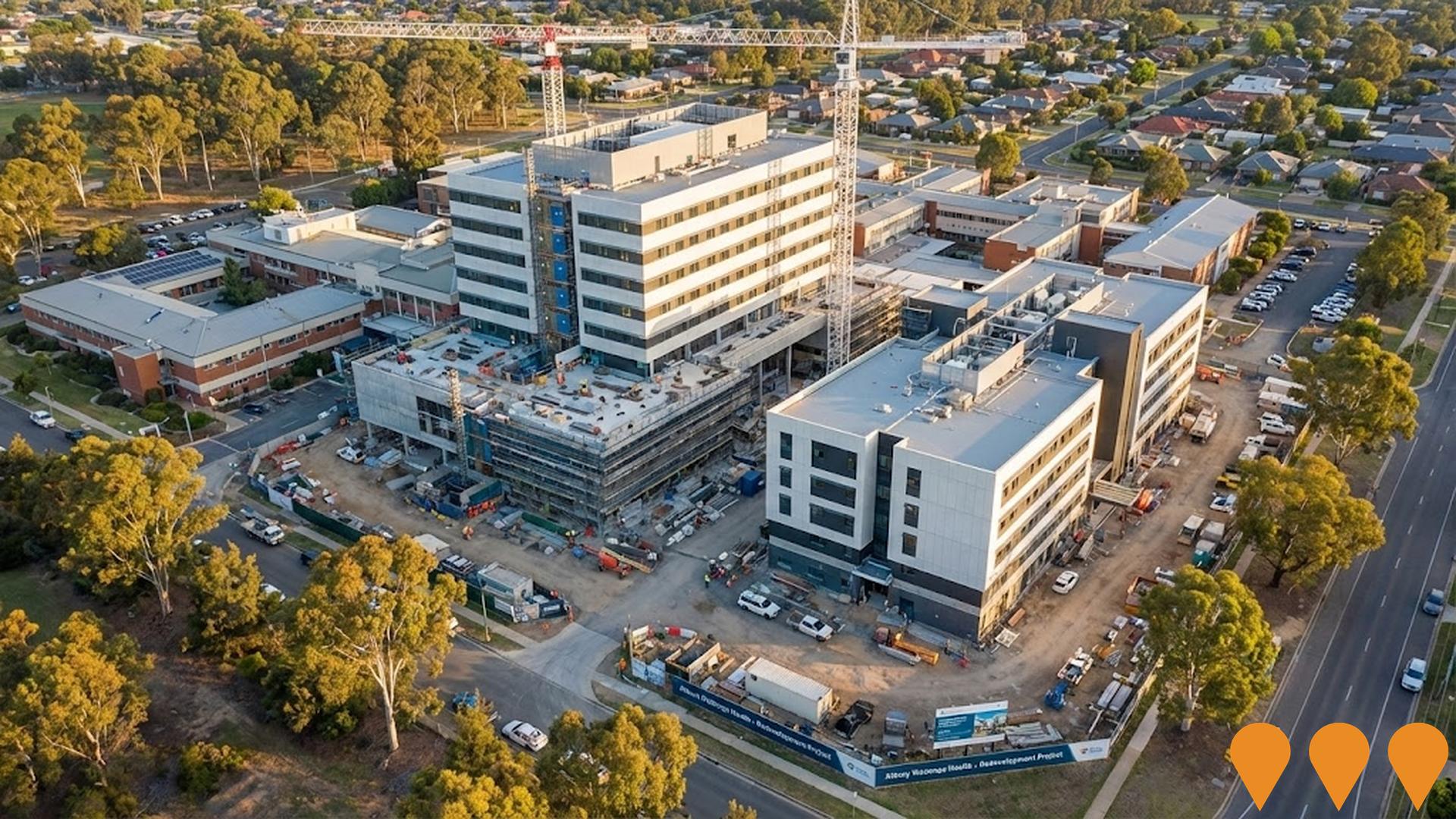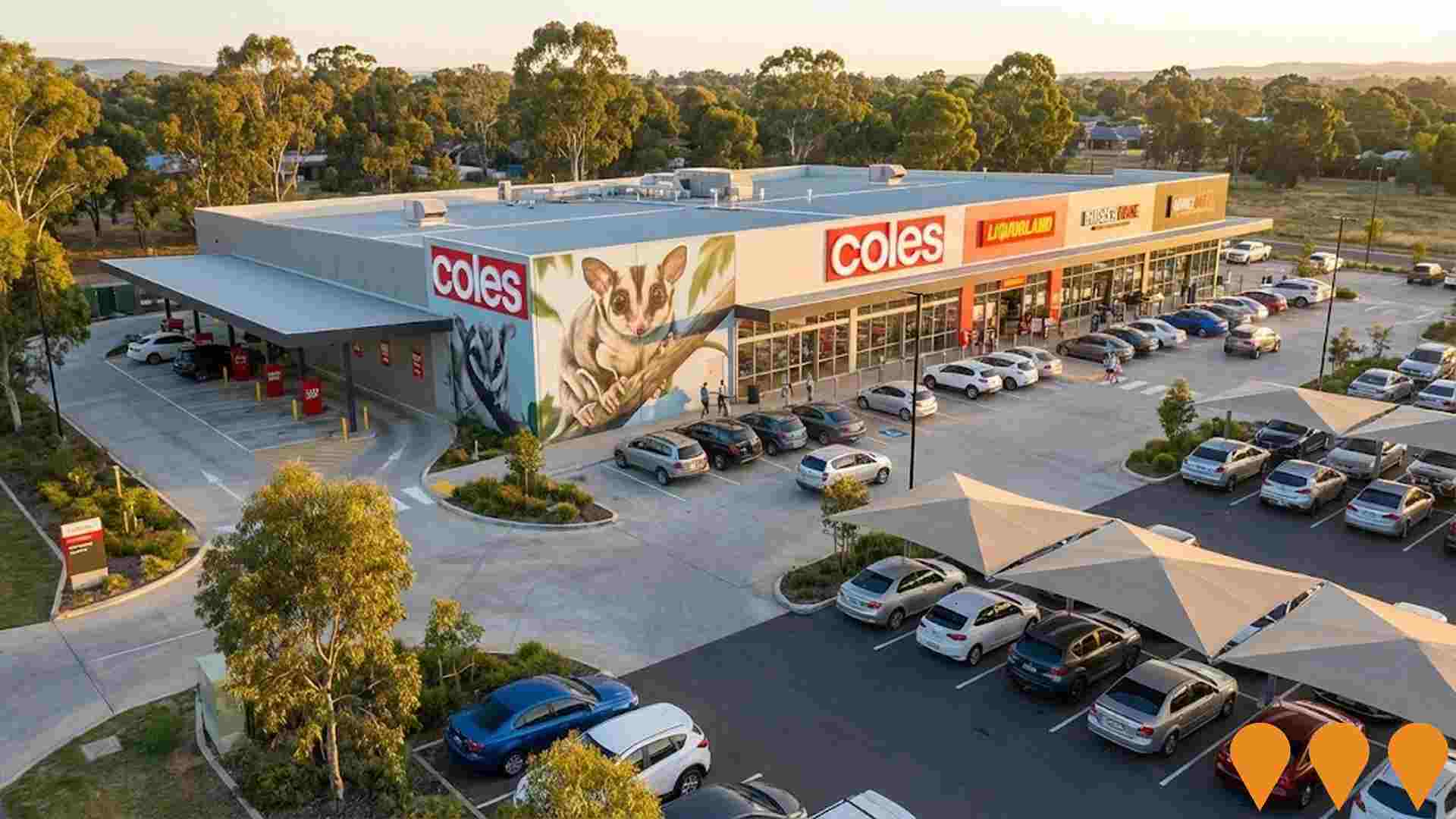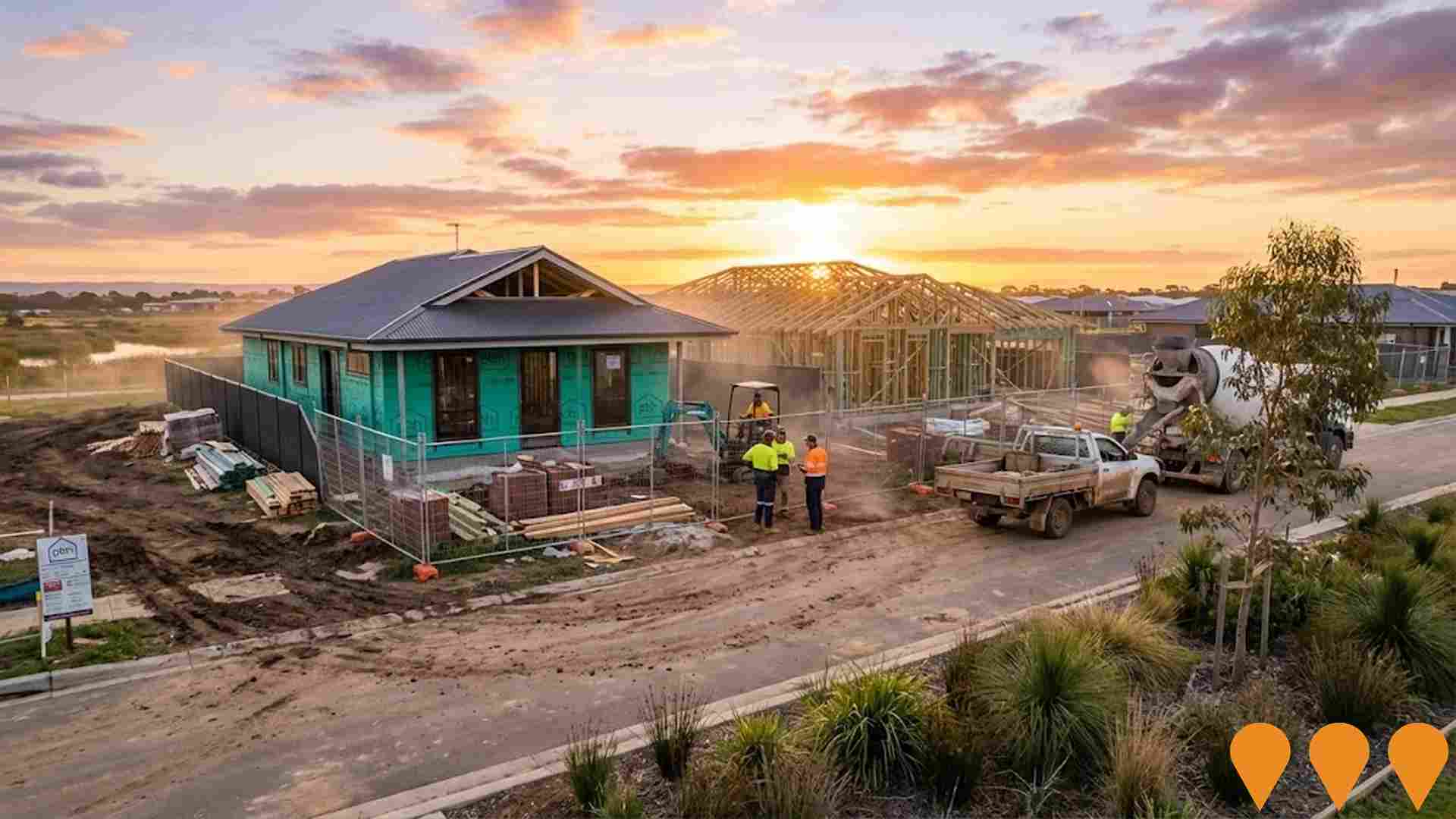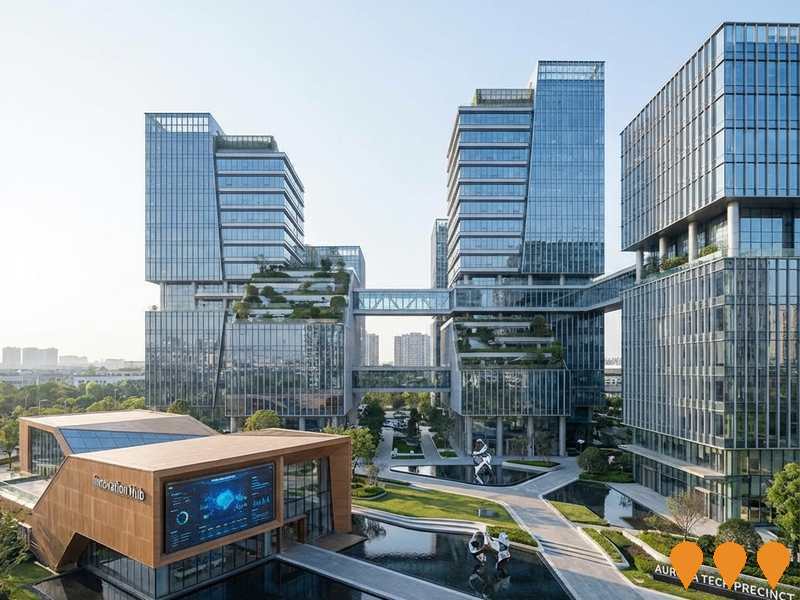Chart Color Schemes
est. as @ -- *
ABS ERP | -- people | --
2021 Census | -- people
Sales Activity
Curious about local property values? Filter the chart to assess the volume and appreciation (including resales) trends and regional comparisons, or scroll to the map below view this information at an individual property level.
Find a Recent Sale
Sales Detail
Population
Albury - East lies within the top 10% of areas nationally in terms of population growth performance according to AreaSearch analysis of short and medium-term trends
Albury-East's population, as of August 2025, is approximately 20,688, indicating a rise of 2,857 individuals since the 2021 Census. This increase represents a 16.0% growth from the previously reported figure of 17,831 people. The change is inferred from the estimated resident population of 20,101 in June 2024 and an additional 888 validated new addresses since the Census date. This results in a density ratio of 203 persons per square kilometer. Albury-East's growth rate surpassed that of non-metro areas (4.8%) and its SA3 region, positioning it as a growth leader. Interstate migration contributed approximately 68.5% to overall population gains during recent periods.
AreaSearch uses ABS/Geoscience Australia projections for each SA2 area, released in 2024 with a base year of 2022. For areas not covered by this data, NSW State Government's SA2 level projections are used, released in 2022 with a base year of 2021. Growth rates by age group from these aggregations are applied to all areas for the years 2032 to 2041. By 2041, Albury-East is projected to expand by 11,935 persons, reflecting a total increase of 54.9% over the 17-year period.
Frequently Asked Questions - Population
Development
The level of residential development activity in Albury - East was found to be higher than 90% of real estate markets across the country
Albury - East has seen approximately 263 new homes approved annually over the past five financial years, from FY-21 to FY-25. This totals 1,315 homes approved during this period, with an additional 55 approvals in FY-26 so far. Each dwelling built has resulted in an average of 2.5 new residents per year over the past five financial years, indicating strong demand that supports property values.
The average construction cost value for these new homes is $487,000. In terms of commercial activity, $69.9 million in approvals have been registered this financial year. Compared to the Rest of NSW, Albury - East has seen 103.0% more new home approvals per person, offering buyers ample choice. However, development activity has moderated recently. Nationally, Albury - East's developer confidence is notably strong, with a substantially higher percentage of new home approvals compared to the national average.
The area maintains a low-density nature, with 95.0% detached dwellings and 5.0% townhouses or apartments. There are approximately 105 people per dwelling approval, suggesting an expanding market. By 2041, Albury - East is projected to grow by 11,348 residents. If current development rates continue, housing supply may not keep pace with population growth, potentially increasing competition among buyers and supporting stronger price growth.
Frequently Asked Questions - Development
Infrastructure
Albury - East has emerging levels of nearby infrastructure activity, ranking in the 36thth percentile nationally
Changes to local infrastructure significantly impact an area's performance. AreaSearch has identified 61 projects likely to affect the area. Notable ones are The Oaks Residential Subdivision, Murray Park Estate, Brooklyn Fields Estate, and Thurgoona Village. The following details projects expected to have the most relevance.
Professional plan users can use the search below to filter and access additional projects.
INFRASTRUCTURE SEARCH
 Denotes AI-based impression for illustrative purposes only, not to be taken as definitive under any circumstances. Please follow links and conduct other investigations from the project's source for actual imagery. Developers and project owners wishing us to use original imagery please Contact Us and we will do so.
Denotes AI-based impression for illustrative purposes only, not to be taken as definitive under any circumstances. Please follow links and conduct other investigations from the project's source for actual imagery. Developers and project owners wishing us to use original imagery please Contact Us and we will do so.
Frequently Asked Questions - Infrastructure
Albury Wodonga Regional Hospital Redevelopment
AUD 558 million joint NSW-Victorian-Commonwealth funded redevelopment of Albury Wodonga Health (Albury Campus). Delivering a new 7-storey Clinical Services Tower and separate Northeast Building. Key features include 80+ additional beds, expanded emergency department, new operating theatres (including hybrid theatre), expanded ICU, new 32-bed adult mental health unit, upgraded maternity and special care nursery, dedicated paediatric unit, and consolidated cancer services. Construction commenced early 2025 by Hansen Yuncken; Northeast Building due for completion 2026, main Clinical Services Tower 2028.

Lavington Swim Centre Redevelopment
The $45.1 million redevelopment (Stage 3) of the Lavington Swim Centre includes a 10-lane 50-metre competition pool, a dedicated 35-metre x 25-metre water polo pool with uniform 2-metre depth, a 25-metre x 15-metre utility pool for lap swimming and remedial use, a splash pad for interactive water play, a new pool building with administration, kiosk, change rooms, amenities, and a Changing Places facility, a flexible multi-purpose social room, and shaded arbour structures with seating, BBQ, and picnic areas. The project replaces the 1967 facility at the end of its service life, aiming to provide modern, inclusive, and accessible aquatic facilities. Stage 3 was endorsed by Council in May 2025 following community consultation, with detailed design underway with Canvas Projects and construction planned to commence in 2027.

Thurgoona Village
A new $17.5 million retail development featuring a Coles supermarket with open-front bakery and dessert bar, Liquorland bottle shop, and specialty stores including Burger Urge restaurant. The development includes 173 car parks with 76 undercover spaces and a six-bay undercover drive-through click and collect service. Features a custom sugar glider mural celebrating the local environmental context.

River Gum
Specialist Disability Accommodation featuring three one-bedroom villas designed for Robust and High Physical Support participants and an adjoining two-bedroom house for Improved Liveability participants. Features customized design elements including wide doorways, adjustable benches, private ensuite bathrooms with underfloor heating, assistive technology, and enhanced physical access provisions. The project represents Good Housing's first development outside Greater Sydney.

Lavington Social Housing Project
A $5 million Social Housing Accelerator Fund development delivering 10 new three-bedroom homes specifically designed for women-led families, particularly those escaping domestic and family violence. At least 10% of homes are allocated to Aboriginal women, with tenants selected from the social housing register. The development features gender-responsive design principles focused on safety, security, and family-friendly layouts.

Murray Park Estate
A masterplanned residential community offering premium house and land packages across 10 stages in Thurgoona. Features lots ranging from 560m2 to 1750m2 with elevated blocks offering views over Albury-Wodonga. The estate includes modern amenities, parks, walking trails, and is located just 12 minutes from Albury city centre and close to shopping centres, schools, and the Murray River.

The Oaks Residential Subdivision
A major residential subdivision providing 198 housing lots in the rapidly growing Thurgoona area. The project was approved by Albury Council in June 2022 and is strategically positioned to benefit from the new Thurgoona Link Road infrastructure. Development was previously delayed pending completion of critical road infrastructure, but with environmental approvals for the link road granted in November 2024, the project is positioned to proceed. The development will contribute to the planned 16,000 additional dwellings in the Thurgoona-Wirlinga growth corridor over the coming decades.

Brooklyn Fields Estate
Master-planned residential estate on over 120 hectares in Thurgoona, delivering more than 1,000 residential lots across multiple stages. Features include extensive parks, walking and cycling trails, a central community park, display village, and 6 hectares of engineered wetlands providing habitat for the threatened Sloane's Froglet. Located close to schools, Charles Sturt University, shopping and recreational facilities.

Employment
Employment conditions in Albury - East demonstrate exceptional strength compared to most Australian markets
Albury - East has a skilled workforce with essential services sectors well represented. The unemployment rate was 2.2% in the past year, with an estimated employment growth of 4.2%.
As of June 2025, 11,822 residents were in work, and the unemployment rate was 1.5% below Rest of NSW's rate of 3.7%. Workforce participation was at 67.6%, compared to Rest of NSW's 56.4%. Leading employment industries among residents comprised health care & social assistance, education & training, and construction, while agriculture, forestry & fishing employed just 1.3% of local workers, below Rest of NSW's 5.3%.
Employment levels increased by 4.2%, and labour force increased by 4.4% during the year to June 2025, causing the unemployment rate to rise by 0.2 percentage points. Jobs and Skills Australia's national employment forecasts from May 2025 project national employment growth of 6.6% over five years and 13.7% over ten years. Applying these projections to Albury - East's employment mix suggests local growth of approximately 6.6%% over five years and 13.8% over ten years, though this is a simple weighting extrapolation for illustrative purposes and does not account for localised population projections.
Frequently Asked Questions - Employment
Income
Income levels align closely with national averages, indicating typical economic conditions for Australian communities according to AreaSearch analysis
Albury - East's median income among taxpayers was $53,064 in financial year 2022. The average income stood at $67,088 during the same period. This compares to figures for Rest of NSW which were $49,459 and $62,998 respectively. Based on Wage Price Index growth of 12.61% since financial year 2022, current estimates would be approximately $59,755 (median) and $75,548 (average) as of September 2025. Census data reveals household, family and personal incomes in Albury - East cluster around the 59th percentile nationally. Looking at income distribution, 36.6% of locals (7,571 people) fall into the $1,500 - 2,999 category. After housing costs, 86.0% of income remains for other expenses. The area's SEIFA income ranking places it in the 6th decile.
Frequently Asked Questions - Income
Housing
Albury - East is characterized by a predominantly suburban housing profile, with ownership patterns similar to the broader region
In Albury - East, as per the latest Census evaluation, 88.4% of dwellings were houses, with the remaining 11.6% comprising semi-detached homes, apartments, and other types. This is compared to Non-Metro NSW's 83.2% houses and 16.8% other dwellings. Home ownership in Albury - East stood at 28.9%, with mortgaged dwellings at 41.9% and rented ones at 29.3%. The median monthly mortgage repayment was $1,625, higher than Non-Metro NSW's average of $1,430. The median weekly rent figure was $320, compared to Non-Metro NSW's $265. Nationally, Albury - East's mortgage repayments were lower at $1,625 versus the Australian average of $1,863, and rents were substantially lower at $320 compared to the national figure of $375.
Frequently Asked Questions - Housing
Household Composition
Albury - East has a typical household mix, with a higher-than-average median household size
Family households constitute 72.0% of all households, including 33.5% couples with children, 27.7% couples without children, and 10.0% single parent families. Non-family households comprise the remaining 28.0%, with lone person households at 24.2% and group households making up 3.7%. The median household size is 2.6 people, larger than the Rest of NSW average of 2.4.
Frequently Asked Questions - Households
Local Schools & Education
The educational profile of Albury - East exceeds national averages, with above-average qualification levels and academic performance metrics
The educational profile of Albury - East stands out regionally, with 26.1% of residents aged 15+ holding university qualifications, exceeding the SA4 region average of 18.4%. Bachelor degrees are most prevalent at 18.2%, followed by postgraduate qualifications (4.6%) and graduate diplomas (3.3%). Vocational credentials are also prominent, with 38.1% of residents aged 15+ holding such qualifications - advanced diplomas at 11.1% and certificates at 27.0%.
Educational participation is high, with 30.5% of residents currently enrolled in formal education. This includes 10.9% in primary education, 7.4% in secondary education, and 4.5% pursuing tertiary education. Albury - East's 3 schools have a combined enrollment of 2,208 students, demonstrating typical Australian school conditions (ICSEA: 1047) with balanced educational opportunities. The educational mix includes 1 primary school and 2 K-12 schools. School places per 100 residents (10.7) fall below the regional average (17.1), indicating some students may attend schools in adjacent areas.
Frequently Asked Questions - Education
Schools Detail
Nearby Services & Amenities
Transport
Transport servicing is moderate compared to other areas nationally based on assessment of service frequency, route connectivity and accessibility
Albury-East has 302 active public transport stops, served by a mix of train and bus routes. These routes total 59, offering 1,101 weekly passenger trips combined. Residents enjoy excellent transport accessibility, with an average distance of 163 meters to the nearest stop.
Service frequency is high, at 157 trips daily across all routes, equating to about three weekly trips per individual stop.
Frequently Asked Questions - Transport
Transport Stops Detail
Health
Albury - East's residents are relatively healthy in comparison to broader Australia with common health conditions slightly more prevalent than average across both younger and older age cohorts
Albury East's health metrics closely align with national benchmarks.
Common health conditions are slightly more prevalent than average across both younger and older age groups. Private health cover is at approximately 52%, impacting around 10,840 people, which is slightly higher than the average SA2 area. Mental health issues affect 9.0% of residents, while asthma impacts 8.9%. About 68.0% of residents report no medical ailments, compared to 64.2% in Rest of NSW. The area has 16.2% of residents aged 65 and over (3,347 people), which is lower than the 20.1% in Rest of NSW. This aligns broadly with the general population's health profile.
Frequently Asked Questions - Health
Cultural Diversity
Albury - East ranks below the Australian average when compared to other local markets across a number of language and cultural background related metrics
Albury-East was found to have below average cultural diversity, with 88.7% of its population born in Australia, 92.4% being citizens, and 92.5% speaking English only at home. The dominant religion in Albury-East is Christianity, comprising 52.5% of the population, compared to 53.9% across Rest of NSW. The top three ancestry groups are English (29.5%), Australian (29.3%), and Irish (10.2%).
Notably, German (5.2%) is overrepresented in Albury-East compared to the regional average of 5.9%, as are Scottish (8.5% vs 8.2%) and Dutch (1.4% vs 1.3%).
Frequently Asked Questions - Diversity
Age
Albury - East's population is slightly younger than the national pattern
The median age in Albury-East is 36 years, which is significantly lower than Rest of NSW's average of 43 years and somewhat younger than Australia's median age of 38 years. The 25-34 age group makes up 15.3% of the population in Albury-East, compared to a higher prevalence in Rest of NSW. Conversely, the 65-74 age cohort is less prevalent at 8.7%. According to data from the post-2021 Census, the percentage of the population aged 25 to 34 has increased from 14.0% to 15.3%, while the percentage of those aged 55 to 64 has decreased from 10.7% to 9.8%. Population forecasts for the year 2041 indicate significant demographic changes in Albury-East, with the 35-44 age group projected to grow by 68%, reaching a total of 5,129 people from the current figure of 3,053.

